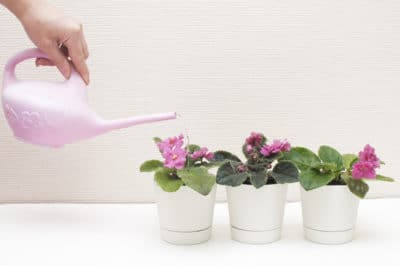The Right Water
Rainwater or filtered water are the best choices for African violets. Tap water often contains chlorine, which can be damaging to the plants. If tap water is your only option, let the water sit out overnight in a bowl or pot to allow chlorine to dissipate. Water should always be room temperature, as African violets are sensitive to abrupt temperature changes.
Self-Watering Pots
To some people, self-watering pots seem like the answer to a prayer for African violets. If you use self-watering systems:
- Monitor by checking the soil at least every other day.
- Transplant at least once a year.
- Pay attention to fertilizer salt build-up in the soil (whitish streaks and clumps).
- Continue to provide additional humidity.
Water From The Bottom
African violets may develop spots on their leaves if they are watered while they are in full sun. Watering from the bottom also prevents the soil from splashing on the leaves or washing out of the pot. Place each violet in a shallow tray or basin filled with room temperature water for 30 minutes. Remove and allow to drain completely.
When To Water
African violets may require more or less water depending on the type of potting soil you use, whether they are actively blooming and other biological conditions. In homes with central heating, humidity may be low, which means more frequent watering. There’s no hard and fast rule, as you must monitor your plants and adjust accordingly. Touch the soil with your fingertip; if it feels dry, water the plant.
How Much To Water
When you do water, make sure the potting soil is evenly moist from top to bottom. The goal is to keep the soil just moist, but to allow water to drain quickly so the roots also have oxygen. Waterlogged soil increases the risk of plant pathogens and may prevent the roots from absorbing nitrogen properly. You may need to water daily in winter when inside air is dry.
Watering to Leach Soil
Depending on how hard your water is, mineral salts may build up in the potting soil. Leach salts by watering the plants with room temperature water until the soil is completely saturated and water runs freely from the drainage holes. Allow the pots to drain completely. Leach about every three months. You should also repot your African violets regularly – at least once a year.
